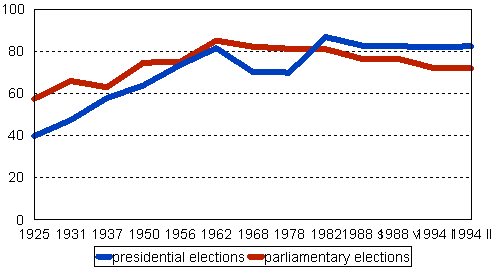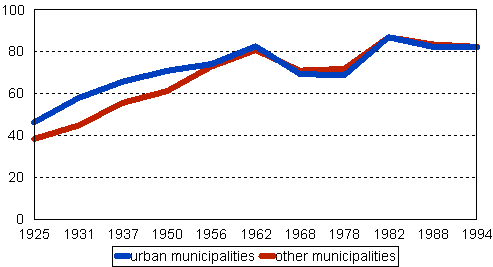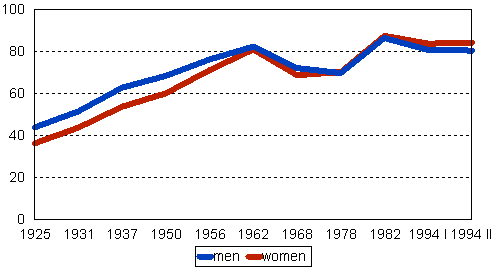The Finnish presidential elections 1919-1994
Up to the 1982 presidential election, the President of the Republic of Finland was elected by an indirect election procedure in which an electoral college of 300 chosen by popular vote convened to elect the president. The Constitution was amended in 1981, raising the number of electors in the electoral college to 301. In the early years of Finnish independence, the legal provisions for presidential elections were contained in the 1922 and 1924 Acts on the Election of the Electoral College and the President of the Republic. The present legal provisions concerning the electing of the president are contained in the Finnish Constitution and the new Electoral Act of 1998.
The President of the Republic of Finland has been elected 17 times, of which six followed an exceptional procedure. The first Finnish President was elected by the Parliament on 25 August 1919. The fourth President of the Republic, Kyösti Kallio, who had been elected president on 15-16 January 1937, resigned the office for reasons of health in 1940. On 19 December 1940, Risto Ryti was elected president for the remainder of Kallio's term of office. In the presidential election of February 1943, Risto Ryti was almost unanimously elected to continue as president. Due to the wartime circumstances, the electoral college of 1937 also performed the elections in 1940 and 1943.
On 4 August 1944, Ryti was followed by Marshal Mannerheim, designated head of state by an exceptive law. Following Mannerheim's resignation from the office, the Parliament chose Juho Kusti Paasikivi as his successor on 4 March 1946. In 1973, the Parliament extended President Urho Kekkonen's term by four years (1974-1978) by a special act.
Presidential election procedure
The presidential election procedure has been reformed twice, in 1987 and 1991, in a more democratic direction. In the first reform of 26 June 1987, the procedure was changed by Acts passed for the Amendment of Sections 23 and 24 of the Finnish Constitution (573/87) and by an Act on the Electing of the President of the Republic (574/87), which gave Finnish citizens the opportunity to choose the President of the Republic in a direct popular vote. The new election procedure was a mixed one in which the electorate not only voted direct for a presidential candidate but also for an electoral college candidate.
Full direct popular vote procedure was adopted in the second reform (Act on the Election of the President of the Republic, 1076/92). The president was elected for the first time by a two-stage, direct popular vote in 1994. In a direct popular vote the electorate give their votes direct to a candidate without an intermediating electoral college. The two-stage procedure means that unless one candidate receives more than 50 per cent of all the valid ballots in the first round, a second election round is held between the two candidates who received the most votes in the first round.
Voting turnout in presidential elections
With the exception of the last three elections, the turnout in elections of presidential electors has generally been distinctly lower than in parliamentary elections. The turnout in the first election for an electoral college in 1925 was very poor at only 39.7 per cent. The preceding year's parliamentary election produced a turnout of 57.4 per cent. The flaccid attitude may partly have been due to the indirect nature of the presidential election: the indirect election procedure differed from parliamentary and municipal election procedures and, consequently, the electorate were unfamiliar with it early on. On the other hand, the fact that, for the first time, the citizens could participate in the electing of the president should have boosted turnout figures. The turnout kept improving, reaching its first peak in the 1962 election, in which the Centre Party of Finland, the Social Democratic Party of Finland, the Democratic League of the People of Finland and the Social Democratic Union of Workers and Small Farmers had each nominated their own candidate. The all-time highest turnout figure was recorded in the 1982 presidential election in which all the main parties had nominated their own candidate. Additionally, President Kekkonen's period of power had come to an end in 1981 when Mauno Koivisto had assumed the duties of the President of the Republic because of Kekkonen's ill health.
Voting turnout - presidential elections and parliamentary elections closest to them

1988 s = direct popular vote, 1988 v = election of presidential electors, 1994 I = first round of presidential election, 1994 II = second round of presidential election
Prior to the 1950s, voters in southern Finland and in urban areas were more active than those in northern Finland and rural areas. However, the set up has changed since then so that in the 1962 and 1968 elections the highest turnouts in the country were recorded in the constituencies of Oulu and Lapland, in the north. The turnout figures of urban and rural areas were already evening out in the 1956 election.
Voting turnout - urban and other municipalities in the 1925-1988 elections of presidential electors and in the first round of the 1994 presidential election

Since 1978 Finnish citizens resident in Finland only
1988 direct election and first round of 1994 presidential
election
Women's participation
Before World War II, the turnout among women was approximately 10 percentage points lower than among men. Especially in the 1960s women started to assume more active roles in society and caught up with men in the voting turnout figures. In the latest parliamentary and municipal elections women's turnout was higher than men's. In the 1994 presidential election women voted more actively than men in both rounds of the election. In the first round, women's turnout was 80.6 per cent and the difference between the genders in the turnout was 3.0 per cent. In the second round of voting, the difference between women and men in the turnout was 3.8 percentage points.
Voting turnout - women and men in the 1925-1982 elections of presidential electors and in the 1994 presidential election

Since 1978 Finnish citizens resident in Finland only
Women have been as candidates in two presidential elections. The Liberal Party's candidate Helvi Sipilä was the first woman candidate in 1982. In 1994, two of the eleven candidates were women: Eeva Kuuskoski, representing an association of eligible voters, and Elisabeth Rehn, representing the Swedish People's Party. Elisabeth Rehn cleared her way to the second round with Martti Ahtisaari.
Support of parties in elections of presidential electors
In the 1980s, the character of presidential elections underwent a change in that they became increasingly elections between individuals, even though the relative support of the parties kept in line with party support in parliamentary elections. In most of the elections, political parties nominated their own candidate whom the party's electors voted at least in the first ballot. The number of electors has been proportional to the number of votes given to a party and the number of representatives a party has in the Parliament.
In the elections of presidential electors, party support has followed traditional lines. Through the ages, the Centre Party of Finland, as well as the Finnish Rural Party, have proportionally received most of their votes in rural areas. Geographically, the Centre Party of Finland has received its strongest support in the constituencies of Oulu, Lapland and North Karelia. The Social Democratic Party has been strong in the Häme north constituency - now the constituency of Pirkanmaa - in other words, around Tampere. The Social Democratic Party, as well as the National Coalition Party, Progressive Party and Swedish People's Party have all received proportionally more votes in urban areas. The support of the Swedish People's Party has come from the constituencies of Åland, Vaasa, Uusimaa and Helsinki.
Support of the major parties in the 1925-1988 elections of presidential electors and in the first round of the 1994 presidential election.

1956 besides being supported by the National Coalition
Party, Tuomioja was also backed by the Liberal Union which received
1.7% of the votes.
1962 support of the Swedish People's Party was divided so that the
party received 5.1%, and Kekkonen's electoral alliance 1.6%, of the
votes.
1962 Kekkonen's electoral alliance received 7.5%, and the Coalition
Party 0.5%, of the Finnish People's Party's votes.
1994 including eligible voter association candidates Keijo Korhonen
(5.8% of the votes), Pertti Virtanen (3.0%), Eeva Kuuskoski (2.6%),
and Pekka Tiainen (0.2%)
Left Alliance, 1945-1987 Democratic League of the People of
Finland
National Coalition Party, until 1916 Finnish Party
Centre Party of Finland, until 1962 Agrarian Party; 1962-1987
Centre Party
Liberal Party, until 1917 Young Finnish Party; 1919-1948 National
Progressive Party; 1951-1962 Finnish People's Party
Sources:
Hirvikallio, Paavo: Tasavallan presidentin vaalit Suomessa
1919-1950 (Elections of the President of the Republic in
Finland 1919-1950, in Finnish only), 1958, WSOY, Porvoo.
Nousiainen, Jaakko: Suomen poliittinen järjestelmä (The Finnish
political system, in Finnish only), 1992, WSOY, Juva.
Suomen Historian Pikkujättiläinen (Concise history of Finland,
in Finnish only), 4th edition, 1990, WSOY, Porvoo.
Statistical Yearbook of Finland 1931, 1946-1947, 1948 and 1998
(1998 table in English).
Tarasti, Lauri: Suomen
vaalilainsäädäntö (Finnish electoral legislation, in Finnish
only), 1987, Edita, Helsinki.
Tilastokatsauksia I-II, (Statistical overviews, in Finnish and
Swedish), 1924-1925, Central Statistical Office of Finland,
Council of State Printing Press, Helsinki.
Official Statistics of Finland, XXIX, Elections, Elections of
presidential electors in 1925, 1931, 1937, 1950, 1956, 1962 and
1968 (Table headings in English from 1956
onwards).
Official Statistics of Finland, XXIX,
Elections, National elections 1978 and 1982.
Official Statistics of Finland, XXIX, Elections, Presidential
elections 1988 and 1994.
Last updated 31 May 2004
Official Statistics of Finland (OSF):
Presidential elections [e-publication].
ISSN=2242-3699. 2000,
The Finnish presidential elections 1919-1994
. Helsinki: Statistics Finland [referred: 30.12.2025].
Access method: http://stat.fi/til/pvaa/2000/pvaa_2000_2004-05-31_kat_001_en.html

